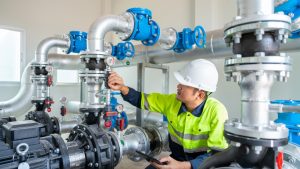Do you know that global machine failure loss is around $1 trillion a year? Businesses nowadays are realising more value in integrating technology to reduce risks related to mechanical assets in the age of technological breakthroughs. These crucial assets, which are used in a variety of sectors, including manufacturing, logistics, and transportation, are prone to failures, malfunctions, and expensive downtime. Fortunately, integrating technology has become a potent answer to these problems, revolutionising asset management.
Integrating technology is important for predicting potential threats for the machines owned by a company, But when the Internet of Things (IoT) links with Artificial Intelligence (AI), the benefit broadens to new horizons. This whole process excels in comprehensive asset tracing, remote diagnostics as well as condition-based monitoring. The industrial world needs to understand that IoT without AI is worthless. A well-integrated technology that collaborates with AI is highly required for all complex businesses to ensure their mechanical assets are safe and out of any potential risks.
In this article, we are going to explore the connection between IoT and AI when the Singaporean industrial world is concerned. Plus, we will discover the stages of reducing risks of mechanical assets through predictive analytics as the best possible answer.
Better Analysis through the Collaboration of IoT and AI

As the IoT grows, sophisticated sensors, cameras, and equipment are gathering and exchanging vast amounts of data on the health and behaviour of a variety of assets, including constructions, transportation networks, institutes of higher education, water transmission lines, electrical power, and much more.
When monitoring assets, sensors and cameras are particularly helpful for determining condition-based indications, allowing operators to manage by exception rather than physically inspecting thousands of components. Administrators of assets can monitor their carbon performance with the use of IoT, which also greatly reduces human involvement and risk mitigation to provide more sustainable results.
In context with this, the core concept behind IoT is real-time connectivity between IT systems and field equipment. It is a concept that enables corporate administrators to record data from assets, such as readings and conditions, and transfer it to an IT system. This can provide the same data in a way that maintenance planners can better comprehend and plan out repair activities.
Hence, an IoT provide useful insights and predictions about potential risks? No! Employing IoT only is pointless. The swift growth of another technology, AI and its subset, machine learning that can combine data from IoT and systems, discover insights, and forecast the long-term performance of assets provides the best answer.
How exactly does this happen? AI employs potent algorithms to go through massive volumes of data and spot patterns. AI could possibly be used to gather and analyse data about a company’s demands or to cut down on the time and resources needed to decide on the best course of action for asset upkeep. In a nutshell, AI relies on data from IoT devices as a platform to assist clients in more effective care of prospective assets.
How exactly does AI help risk management? Asset allocation decisions must be made to build a portfolio with a certain mix of risk and return. AI tools can aid in this process by enabling basic analysis via textual or quantitative analysis of data and creating new investing strategies.
Now that you know how IoT and AI work together to control risks, you can understand how businesses can operate asset maintenance with more flexibility and agility.
Stages of Reducing Risks of Mechanical Assets through Predictive Analytics

When reducing risks for mechanical assets is concerned, you can not continue your discussion without ‘Predictive Analytics’. An enterprise could employ this useful tool, predictive analytics to estimate the potential threats that can be coming their way to lose control of the valuable assets they have. Simply said, through contemporary and historical data, predictive analytics gives extremely helpful future predictions of enterprise assets. In order to boost the accuracy and powerfulness of the predictions, predictive analytics gets partnered with two other components, such as machine learning and data mining. In the section below, we will walk you through the stages of predictive analytics when reducing risks of mechanical assets.
Monitoring Mechanical Assets
Predictive analytics plays a key role in reducing risks by monitoring mechanical assets. To be helpful in the decisions, data on asset performance, operational circumstances, and health are collected in real-time. Companies can guarantee optimal asset performance by tracking crucial characteristics like temperature, vibration, and pressure by putting in place a reliable monitoring system. With the help of remote monitoring tools, businesses can access real-time data from any location and quickly identify any problems.
Algorithms for anomaly detection examine the data that has been acquired and notify the appropriate parties of any departures from the usual pattern. Optimising maintenance schedules based on asset conditions enables companies to embrace condition-based maintenance. Monitoring mechanical assets offers proactive risk avoidance and improves operating efficiency by utilising predictive maintenance and performance improvement.
Capturing Possible Risks
A critical step in the process of using predictive analytics to lower the risks associated with mechanical assets is to identify any potential issues. It involves locating and assessing potential risks that can affect the effectiveness, dependability, and durability of mechanical assets. Businesses can recognise typical failure mechanisms and evaluate the likelihood and seriousness of risks by combining historical data analysis, expert knowledge, and industry standards.
When it comes to capturing risks, this includes making a thorough examination of different sorts of factors such as the age of the assets, patterns the company utilises certain assets, the environmental conditions, and the history of the maintenance. Having insights into these components, businesses have a high possibility to predict the vulnerable assets and critical points to be taken into consideration immediately and prevent possible breakdowns.
It’s common knowledge that predictive analytics make the way to capture potential risks by looking into the information on the asset history as well as the advanced algorithms it has to understand the patterns. While looking into the history of performance failures, companies can discover the reasons for them and possible risks that can affect the future of the asset.
Businesses can implement proactive steps to identify areas of concern and reduce the chance and effect of failures by using predictive analytics to capture any possible risks. By enhancing asset dependability, capturing the best financial scenarios, lowering downtime, and optimising maintenance efforts, this proactive strategy raises operational effectiveness while reducing dangers associated with mechanical assets.
Pointing Out Actionable Insights
The delivery of useful information via predictive analytics is crucial for mechanical risk management. Businesses can discover a great deal about the functionality, condition, and possible dangers of mechanical assets by examining historical data, real-time sensor inputs, and other relevant data. This makes it possible to take preventative actions like scheduling maintenance tasks, changing out problematic parts, or modifying operational settings.
Large enterprises could enhance operational efficiency, minimise downtime, and optimise asset maintenance thanks to the practical findings produced by predictive analytics, which will ultimately lead to better performance. Companies can reduce the potential financial losses, safety concerns, and operational interruptions brought on by mechanical asset breakdowns by promptly addressing risks.
Hence, using predictive analytics for mechanical risk management enables companies to make wise choices, efficiently allocate their resources, and assure the dependability and durability of their assets. It improves risk reduction techniques and helps different companies and sectors function better overall and sustainably.
Assisting to Comply with Regulations
The use of predictive analytics by companies to comply with rules and legislation is of the utmost significance. Businesses are able to anticipate potential risks and maintain regulatory compliance by analysing patterns and trends using historical data and sophisticated algorithms. Predictive analytics allows companies to proactively track and recognise any variations from legal requirements, permitting prompt action and corrective measures.
This technology helps in highlighting incompatible behaviours, prospective compliance violations, and opportunities for development. Companies can minimise legal risks, maintain regulatory compliance, and develop a culture of adherence to rules and regulations by incorporating predictive analytics into compliance procedures. This will ensure operational efficiency and safeguard their reputation in the market.
Saving Money and Time
Did you know that around 96% of companies have experienced unexpected downtimes during the last three years? A practical option that saves companies money and effort is to use predictive analytics for machine risk management. Predictive analytics, which we discussed in the sections above, enables proactive risk reduction by identifying prospective threats and evaluating historical data and real-time information.
This proactive strategy minimises unexpected downtime and related costs by lowering the chance of expensive equipment malfunctions. Predictive maintenance plans help improve resource allocation, save unnecessary maintenance tasks, and cut down on operating expenses. Businesses can save money by utilising predictive analytics to streamline their entire operations, increase equipment uptime, and optimise maintenance, all while saving important time.
Empower Your Business for a Safer Tomorrow

Now you might understand that any company needs that strong collaboration of IoT and AI if they need to reduce the potential risks that can cause the loss of Billions of money per year. That’s where predictive analytics enter the scenario as the best option. As it was mentioned above, predictive analytics can empower your business journey when it comes to risk management and saving your money. A machine can bring you trillions of money as well as the same machine can cause trillions of losses if it is not maintained well. With predictive analytics, your business is safe!
Connect with Tigernix to learn how our premium IoT and predictive analytics capabilities are currently boosting the mechanical asset sector in Australia by granting them industry 4.0 capabilities.







